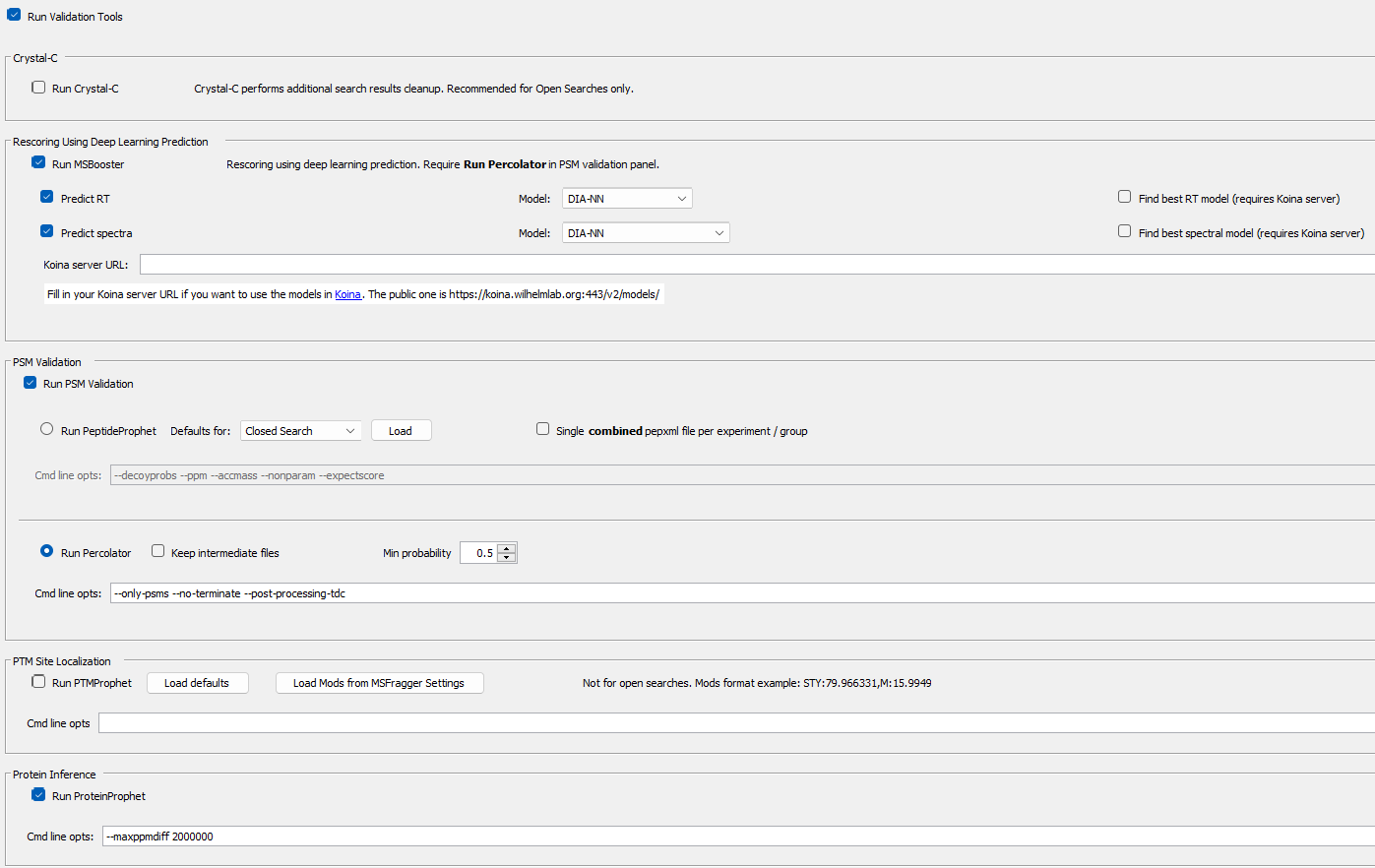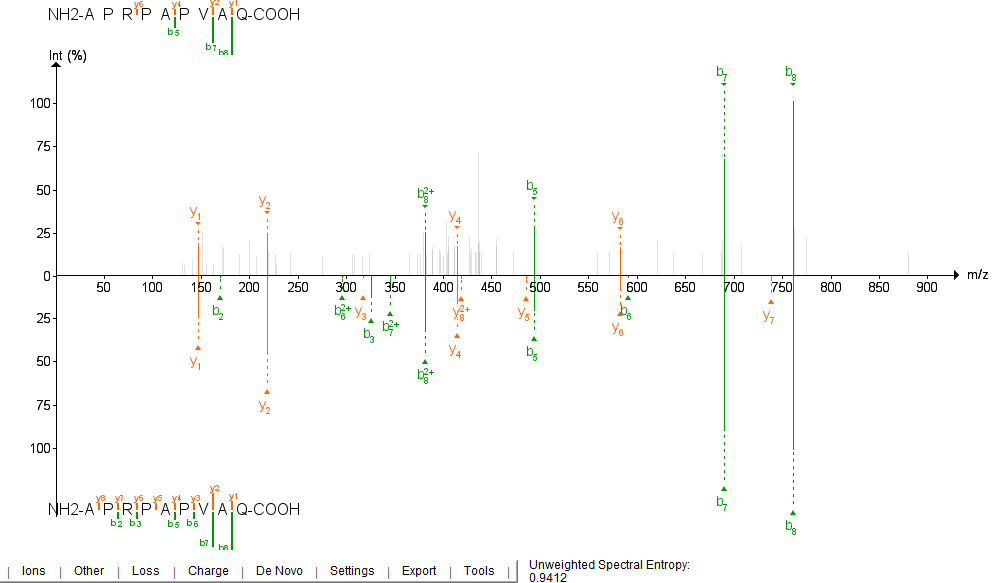Use peptide prediction models from Koina for MSBooster feature generation
Koina is a web server that allows users to get MS2, retention time (RT), and ion mobility (IM) predictions from multiple machine and deep-learning models from the community. It can be tedious running each model separately due to differences in supported peptides, string formatting, and accessibility. Koina combats this by providing a central hub where all models can be queried in a similar fashion. MSBooster uses the Koina API to gain access to these different models, some of which will outperform the FragPipe default of DIA-NN depending on the types of data they were trained on. Below we demonstrate two different ways to use Koina, either by explicitly choosing a model of your choice or by letting a heuristic best model search algorithm make that decision for you.
Example dataset: HLA
This tutorial uses one mzML file from the HLA Ligand Atlas. It has been searched by MSFragger, producing a pin file, a pepXML file, and a fragger.params file. All files can be downloaded from the Google Drive link here.
- If you have not already, please download the latest FragPipe. Koina is available as of version 22.0.
-
Load your mzML file.

-
Load the “Nonspecific-HLA” workflow from the workflow tab. Then you can uncheck the MSFragger checkbox, only running the steps in the validation tab. It should look like this.

- Set your output directory in the run tab to the Koina_MSBooster_tutorial folder
Running with the default DIA-NN model
The default prediction model for both MS2 spectra and RT in MSBooster is DIA-NN. If we run our workflow, we’ll see 2615 peptides passed 1% PSM and peptide FDR cutoffs. This number may vary slightly based on differences in software versions
Choosing a Koina model
We have our baseline performance at 2615 peptides with DIA-NN predictions. It is important to note that these peptides were fragmented with CID instead of HCD. It is unclear whether DIA-NN was trained CID data or not. However, Prosit has an explicit CID model. Let’s swap in Prosit for DIA-NN.
Before using Koina, we must specify a Koina server URL. The publicly available one is
https://koina.wilhelmlab.org:443/v2/models/. Copy-paste this into the text box, if you are ok with sending out predictions
to an external server. Don’t worry, the peptides submitted for prediction are not stored by the server! If you are working
with confidential data, consider setting up your own Koina server.
Next, use the dropdown menus to choose the Prosit models.

Run this workflow now, and we get 2818 peptides. 200 more IDs!
Heuristic best model search
Let’s say you don’t know what models are best suited towards your data. There are some general guidelines you can follow
here based on our tests, but as more models get added
to Koina, the number of models to choose from may become overwhelming. To address this, we have implemented a “best model
heuristic search” algorithm that tries to find the model best suited for you data. You can activate it by checking the
Find best ___ model checkboxes. Both DIA-NN and Koina models will be considered.

Let’s look at the log to see what’s going on:
### RT model search
2024-08-05 15:28:41 [INFO] - Searching for best RT model for your data
2024-08-05 15:28:41 [INFO] - Searching the following models:
2024-08-05 15:28:41 [INFO] - [DIA-NN, Deeplc_hela_hf, AlphaPept_rt_generic, Prosit_2019_irt, Prosit_2020_irt_TMT]
Iteration 1...2...3...4...5...
2024-08-05 15:28:53 [INFO] - DIA-NN has root mean squared error of 3.5497
Iteration 1...2...3...4...5...
2024-08-05 15:28:56 [INFO] - Deeplc_hela_hf has root mean squared error of 3.3044
Iteration 1...2...3...4...5...
2024-08-05 15:28:57 [INFO] - AlphaPept_rt_generic has root mean squared error of 2.8290
Iteration 1...2...3...4...5...
2024-08-05 15:28:59 [INFO] - Prosit_2019_irt has root mean squared error of 3.7188
Iteration 1...2...3...4...5...
2024-08-05 15:29:00 [INFO] - Prosit_2020_irt_TMT has root mean squared error of 9.6557
2024-08-05 15:29:00 [INFO] - RT model chosen is AlphaPept_rt_generic
In the RT model search, MSBooster takes 1000 high-quality PSMs to perform RT calibration. While the root mean squared error (RMSE) metric is shown, a “top consensus” method is used, described in more detail in our paper. That is to say, the model with lowest RMSE may not be the one chosen. Still, RMSE is an informative metric to know the dispersion of predicted RTs. Prosit TMT has the largest RMSE, which is expected since we aren’t working with TMT data. Ultimately, AlphaPeptDeep RT is chosen.
### Spectral model search
2024-08-05 15:29:00 [INFO] - Searching for best spectra model for your data
2024-08-05 15:29:00 [INFO] - Searching the following models:
2024-08-05 15:29:00 [INFO] - [DIA-NN, ms2pip_2021_HCD, AlphaPept_ms2_generic, Prosit_2019_intensity, Prosit_2023_intensity_timsTOF, Prosit_2020_intensity_CID, Prosit_2020_intensity_TMT, Prosit_2020_intensity_HCD]
2024-08-05 15:29:11 [INFO] - Median similarity for DIA-NN is 0.8155
2024-08-05 15:29:13 [INFO] - Median similarity for ms2pip_2021_HCD is 0.7662
2024-08-05 15:29:13 [INFO] - Calibrating NCE
2024-08-05 15:29:19 [INFO] - Best NCE for AlphaPept_ms2_generic after calibration is 20
2024-08-05 15:29:19 [INFO] - Median similarity for AlphaPept_ms2_generic is 0.8888
2024-08-05 15:29:19 [INFO] - Consider lowering minNCE below 20
2024-08-05 15:29:19 [INFO] - Calibrating NCE
2024-08-05 15:29:29 [INFO] - Best NCE for Prosit_2019_intensity after calibration is 20
2024-08-05 15:29:29 [INFO] - Median similarity for Prosit_2019_intensity is 0.8777
2024-08-05 15:29:29 [INFO] - Consider lowering minNCE below 20
2024-08-05 15:29:29 [INFO] - Calibrating NCE
2024-08-05 15:29:35 [INFO] - Best NCE for Prosit_2023_intensity_timsTOF after calibration is 20
2024-08-05 15:29:35 [INFO] - Median similarity for Prosit_2023_intensity_timsTOF is 0.8878
2024-08-05 15:29:35 [INFO] - Consider lowering minNCE below 20
2024-08-05 15:29:37 [INFO] - Median similarity for Prosit_2020_intensity_CID is 0.9598
2024-08-05 15:29:37 [INFO] - Calibrating NCE
2024-08-05 15:29:44 [INFO] - Best NCE for Prosit_2020_intensity_TMT after calibration is 21
2024-08-05 15:29:44 [INFO] - Median similarity for Prosit_2020_intensity_TMT is 0.6300
2024-08-05 15:29:44 [INFO] - Calibrating NCE
2024-08-05 15:29:50 [INFO] - Best NCE for Prosit_2020_intensity_HCD after calibration is 20
2024-08-05 15:29:50 [INFO] - Median similarity for Prosit_2020_intensity_HCD is 0.8918
2024-08-05 15:29:50 [INFO] - Consider lowering minNCE below 20
2024-08-05 15:29:50 [INFO] - Spectra model chosen is Prosit_2020_intensity_CID
Here we see details of the best MS2 model search. As expected, Prosit CID performs the best, since it is the only CID model currently Koina. Additionally, we see that the optimal normalized collision energy (NCE) for prediction is below 20%. This is something you can customize in the MSBooster standalone version.
Ultimately, this further optimized model combination results in 2863 peptide IDs, ~50 peptides more than using Prosit’s RT model. Neat!
Visualizing predictions in FragPipe-PDV
Starting from v1.2.1., FragPipe-PDV can be used to visualize mirror plots of
experimental vs predicted spectra for both DIA-NN and Koina models. The prediction file to load is determined by what
model you ran last (printed in msbooster_params.txt). Koina predictions are saved in the file ending in koina.mgf.
While DIA-NN does not predict y/b-1/2 ions, many of the Koina models do. Peep the y1 and y2 ions!

Summary
MSBooster uses the Koina API to gain access to many more prediction models, leading to increased peptide IDs when there is a better model than DIA-NN. Please refer to the MSBooster documentation for more details, such as what QC figures are generated when Koina is run.
References
- MSBooster paper: Yang KL, Yu F, Teo GC, Li K, Demichev V, Ralser M, Nesvizhskii AI. MSBooster: improving peptide identification rates using deep learning-based features. Nat Commun. 2023 Jul 27;14(1):4539. doi: https://doi.org/10.1038%2Fs41467-023-40129-9. PMID: 37500632; PMCID: PMC10374903.
- Koina preprint: Lautenbacher L, Yang KL, Kockmann T, Panse C, Chambers M, Kahl E, Yu F, Gabriel W, Bold D, Schmidt T, Li K, MacLean B, Nesvizhskii AI, Wilhelm M. Koina: Democratizing machine learning for proteomics research. bioRxiv [Preprint]. 2024 Jun 3:2024.06.01.596953. doi: https://doi.org/10.1101%2F2024.06.01.596953. PMID: 38895358; PMCID: PMC11185529.
- Data used in tutorial: Marcu A, Bichmann L, Kuchenbecker L, Kowalewski DJ, Freudenmann LK, Backert L, Mühlenbruch L, Szolek A, Lübke M, Wagner P, Engler T, Matovina S, Wang J, Hauri-Hohl M, Martin R, Kapolou K, Walz JS, Velz J, Moch H, Regli L, Silginer M, Weller M, Löffler MW, Erhard F, Schlosser A, Kohlbacher O, Stevanović S, Rammensee HG, Neidert MC. HLA Ligand Atlas: a benign reference of HLA-presented peptides to improve T-cell-based cancer immunotherapy. J Immunother Cancer. 2021 Apr;9(4):e002071. doi: https://doi.org/10.1136%2Fjitc-2020-002071. PMID: 33858848; PMCID: PMC8054196.